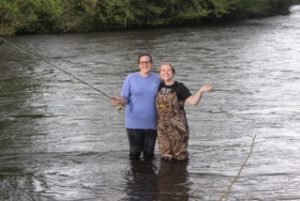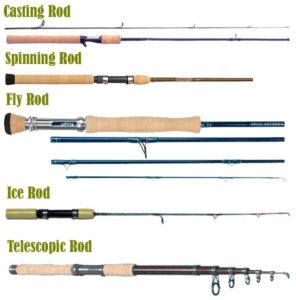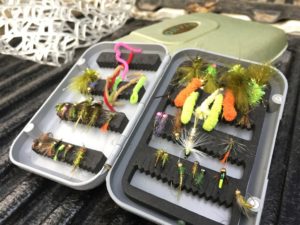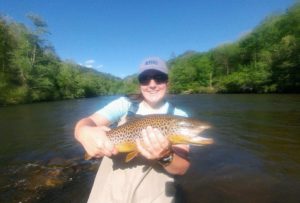This story was co-written with Ashley Kairis
Fly fishing is immensely popular in western North Carolina.
According to The WNC Fly Fishing Trail, Jackson County alone has more than 4,000 miles of trout streams and is the home of the state record for the largest rainbow trout ever caught.

Jessica Wooten and Ashley Kairis learning how to fly fish on the Tuckaseegee River. Photo taken by Kayla Minion
Living in an area that has such a heavy concentration on the sport, we felt that, in order to accurately tell our readers about the basics of fly fishing, we needed to get out on the Tuckasegee River and give it a try ourselves.
Seasoned pro and WCU student, Taylor Seagroves agreed to spend the afternoon with us for some “Fly Fishing 101,” where we began to learn all that goes into an outing on the river. Starting off can be tough for some beginners, and we certainly had our challenges, from becoming familiar with the equipment to putting it into practice. We spent a lot of time on dry land getting the feel for casting and to get more knowledge of the technique before taking on the river.
Check out the video below for a look at how our journey went as first timers on the Tuckasegee River.
Video filmed and edited by Kayla Minion
It’s important to note the main differences between what most may think of as regular fishing, or bait cast fishing, and fly fishing.
Two main differences are the type of rod and the type of bait. Because of the difference in poles, the way you cast is completely different, making fly fishing a whole new skill to learn even for those who are experienced fishers with the average pole.

The various types of fishing rods
Photo courtesy of Fishing Manual
Many who are familiar with bait cast fishing will know what a bobber is. It is a plastic object you attach to your line that floats on the water and will duck under the water to notify the fisher that there is a fish biting at your bait.
In fly fishing, a similar concept is available for those who choose to fish with it and it is called a strike indicator. It is made of a styrofoam material and floats on the surface of the river.
The type of bait you use to catch fish with a fly pole are simply called flies and there is also a sub-category of these flies called nymphs. This differs from bait cast fishing where bait can vary between lures with real or artificial worms and have different hook types such as treble hooks.
Depending on whether you are fly fishing in a river or lake has an impact on the type of flies that will yield the best outcome of catching fish. From speaking with Seagroves, we learned that fishing with worms as bait while fly fishing is illegal and it is also illegal to use a treble hook when fishing for trout.
“I don’t know about places that aren’t around here, but I know the sections near here don’t allow it,” said Seagroves.
According to the NC court system, fishing without a license is a class three misdemeanor and will result in a $35 fine for residents of North Carolina, and jumps to $75 for out of state residents. In some cases, after other fees are added, citations can add up to nearly $200.

A variety of hand tied flies made by local fisherman, Ryan Pless
Photo by Ashley Kairis
Needless to say, it is better to stop by your local Walmart or fishing shop to cover your bases so your trip on the water is not a costly one.
Flies can be crafted to float on the water or sink just below the surface and the idea, if you are fishing in a river, is you cast out your bait and allow your bait to flow naturally with the current to trick the fish into believing it is a real bug that is floating near the surface. If you do it just right and make it just enticing enough, you make get a bite! Then, the game is on.
The flies are usually tied together out of materials such as hair, fur and feathers.
Now you know the basic concepts of fly fishing, you’ll be able to use them when you fly fish for the first (or even second) time. Here are a few tips from Seagroves as guidance for what future fly fishers should and shouldn’t do when out on the river.
You should:
1. Wet your hands before touching the fish.
Having a dry hand can remove the mucus on the fish’s scales and increase the risk of exposure to disease.
2. Keep the fish out of the water for as little time as possible.
Release the fish as soon as you can, especially if it’s extremely cold or hot outside. If not, the fish may die.
3. When it comes to Fly selection, ask around.
Knowing which fly to use can be intimidating. People in fly shops or other fishermen on the river can have good tips on what’s working at the time. Don’t be afraid to ask for help!
You should not:
1. Face down stream or straight across when wading across a river.
When wading across the river in slightly stronger currents, either face slightly or fully upstream to help keep from falling.
2. Put random fly line on a random fly rod (i.e. Putting a 5 weight line on an 8 weight rod).
Rods and lines come in specific weights for a reason. A mismatch in the weight can have an impact on the performance of the rod and line. So if you have a 5 weight rod, be sure to put 5 weight line on it. Once again, if you’re unsure, ask for help!
3. Set the hook too hard, when setting the hook on a fish.
The tippet is very thin and can break easily, especially when using a lighter tippet (i.e. A 7x tippet is lighter and thinner than a 5x tippet). Often a quick lift of the rod tip, combined with a quick and slight pull on the line does the trick to hook a fish.

Ashley Kairis with her first fly fishing catch, a two foot brown trout caught on the Tuck
Photo by Ryan Pless
These are just a few guidelines local fishermen offer when fly fishing. If you are inspired to try out the sport, there are many businesses local to the WCU area that offer insight on where to fly fish and have gear to get you started.
For more information about licenses, equipment, rules, and regulations on hunting or fishing, visit the NC Wildlife Resources Commission. If you are planning to go fishing on the Tuck, you can also check out the water’s stream flow and release schedule as well as the trout stocking schedule so you know what to expect out there.



